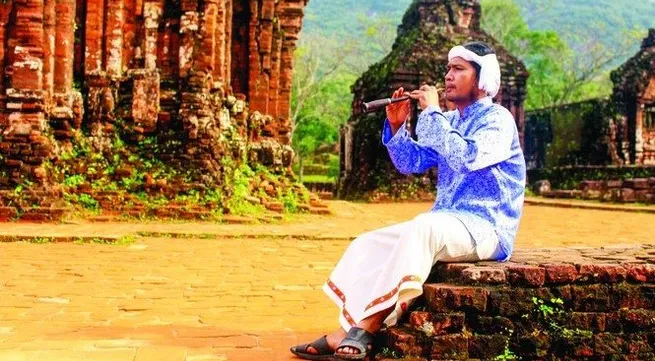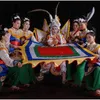Joint efforts to preserve Cham culture

Thien Thanh Vu (1990), who is one of four Cham artisans working for the art troupe in the Department, has played many kinds of traditional musical instruments of Cham ethnic group. Vu was born into a family with three generations of crafting and playing Cham musical instruments, in Ninh Phuoc District, Ninh Thuan Province. Since he was just 12 years old, Vu has studied the methods to craft and play traditional instruments.
Now he can fluently plays many kinds of instruments, such as paranung drum, saranai flute and kanhi lute. In particular, saranai flute, an indispensable instrument for performances. It used to be made of buffalo horn or elephant bone and ivory. However, Cham ethnic people now make the flute from the duramen of an old taramind trees. The structure of a saranai flute symbolises a human body with three parts: head, body and leg. The seven notes on the flute are like seven parts in a face.
The way of playing the instrument is also different. The artisans often blow a long breath from five to 30 minutes according to each piece of music. Therefore, it took many years for artisans to learn the way to blow, take and keep their breaths so that the sound will not be broken. Vu learnt the method to take his breath for two years and took five years to learn how to use the instrument proficiently.
The traditional folk musical instruments are used only during the major festivals of Cham ethnic people such as the tower opening ceremony and Kate festival. The ethnic people possess 72 piece of music, each of which is dedicated to a god and is also suitable for a festival.
Vu’s father, artisan Thien Sanh Them, has performed in many localities. He is knowledgeable about traditional music and instruments as well as always being willing to learn new things from others. The artisan taught his son to play the traditional instruments right at home. Vu now succeeds his father as well as continues to learn and manufacture the instruments to promote his homeland’s culture in My Son Sanctuary.
Vu met folk artisan Truong Ton, who is dedicated to Cham culture and worked in My Son. With the aspiration to transfer his career to the younger generations, late artisan Truong Ton shared many pieces of music with Vu. In 2010, Vu accepted the invitation to work for the Management Board for My Son Cultural Heritage.
The Department of Cham folk culture and arts has now four artisans. There are six performances of Cham people’s dance and musical instruments per day at the My Son Sanctuary relic site, including four at the performing house and two inside the towers, attracting over 1,000 audience members.
Artisan Thien Thanh Vu shared: “Each day, witnessing the audiences’ excitement for the performances, I am more eager to preserve and further promote the cultural identities of Cham group. I always feel the sacredness as well as the respect for the gods and Cham people’s cultural characteristics when playing traditional music in the sanctuary”.
Along with Vu, Phu Binh Huyen (1997) left to My Son in 2014. He is used to teaching children in his hometown how to play traditional instruments. Huyen is the second artisan in the art troupe blowing the saranai flute. He said: “I have learnt to play the instruments since I was very young. I always aspire to transfer the traditional culture to younger generations so that there are more people who can play Cham musical instruments”.
Vu and Huyen took turns performing in the My Son Sanctuary for many years. They also considered My Son as their second homeland. Every day, thousands of visitors enjoy the sound of saranai flute among the sacred sanctuary to feel the artisans’ love for the Cham cultural identities.
Tags:





